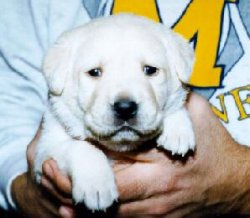Shades of Yellow
You might have seen the ads, "Rare
white Labrador puppies" or "Rare fox red" or "cinnamon"
or "honeybacked" or "Golden Labs". These are
not rare, these are just normal varying shades of yellow.
These ads are preying on an unsuspecting public. Don't fall
for it.
Golden Labs: Actually a
Golden Lab is a cross between a Golden Retriever and a Labrador
Retriever. The proper term is Yellow. Doesn't matter
what shade of yellow, its yellow. Again, don't fall for
anyone calling them Golden Labs and its recommended you don't
use the term either when describing a Labrador.
From the AKC Standard in regards
to the yellow coloring: "Yellows may range in color from
fox-red to light cream, with variations in shading on the ears,
back, and underparts of the dog."
Pale Yellow

|
This is
a very light yellow. Some would call this white, which
is incorrect. Its still a yellow, just a very pale
color. |
Light Cream
 |
This is
a light cream yellow. Though the body is light, the
ears, the face, the hocks and the tip of the tail have shading. |
Medium yellow
 |
This is
more of a medium yellow. Not as light as the one above,
but not extremely dark. |
Dark Yellow
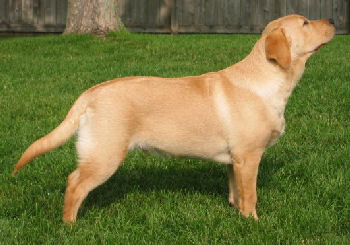 |
This is
a dark yellow. Not a fox red, but definitely darker
than the average yellow. Nothing rare about this color
either. |
This dark
yellow pup will probably continue to darken up as it grows.
You can see the "skirts" of the pup are lighter
than the rest of his and he has shading throughout his body. |
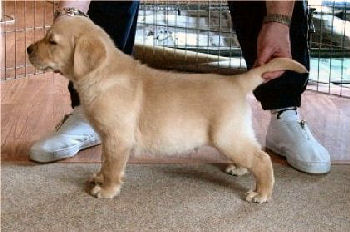 |
Fox Red

|
This is
a fox red Labrador. Though you don't see a lot of
them around, they are hardly rare. |
If they
are fox red, they will be red from birth. |
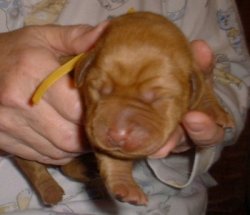
Photo courtesy of Little River Labradors
|

Photo courtesy of Little River Labradors |
Plus they will stay
that red color as they mature. |
| The owner of this gorgeous red dog has written
an interesting article
about fox red Labradors. |
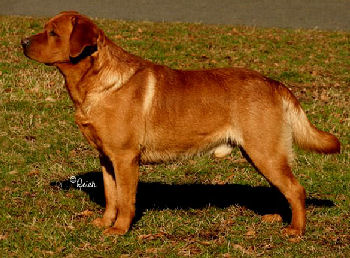
Photo courtesy of Little River Labradors
|
One of the
fun things about yellow Labradors is the different variations
of the yellow coat.
As stated in the standard,
there are but three (3) colors of Labrador Retrievers. However,
the chinchilla factor can be present in some yellows.
Picture a chinchilla. Their
shading involves a white hairshaft with a colored tip. The
chinchilla effect can vary from barely noticable to just
the very tip of the hairshaft having color.
|
|
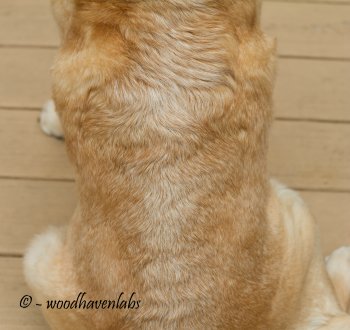
|
Here is a darker yellow Lab showing a
dramatic chinchilla effect. This dog has a mixture of
tip varieties in the coat.
This is not common, but it's not rare
either. Beware of anyone trying to sell you a rare chinchilla
Labrador, just as you would any other "rare"
color.
|
In General
 |
This dog
was a result of breeding a dark yellow to a fox red.
Doing so does not guarantee you will get fox red puppies.
The pups were all varying shades of dark yellow, but none
were actually a fox red. |
This pup is a repeat
of the dog above's breeding and you can see the dark coat.
He is still not a fox red, but a dark yellow. Note
the shading on his shoulders and rear "skirts". |
 |
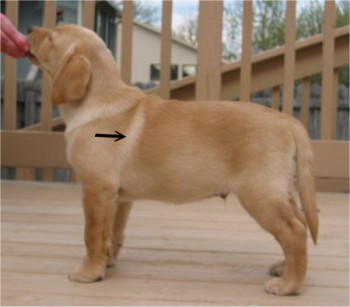 |
This dark
yellow is showing classic "angel wings" (white
shading) over the shoulders. Most yellows have this
so it is not rare. If you look at the fox red puppy, he
also is showing "angel wings". |
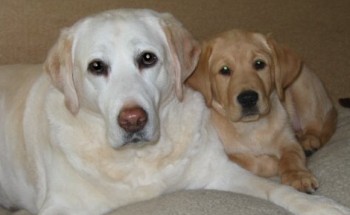 |
This picture
shows you the difference in yellow shades. The dog
on the left is a light cream. The dog on the right
is a dark yellow. (they are related, but not mother-son) |
This photo
shows the contrast between the yellow shades. |
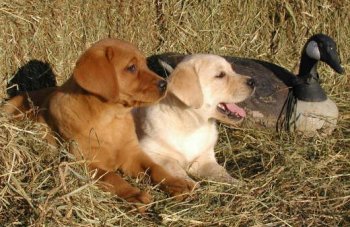
Photo courtesy of Little River & Penara
Labradors |
Some yellows get darker as they
age so that light puppy might turn into a darker adult. The
following pictures are of the same dog.
The first one was taken when the
dog was 3 weeks old. The second at 2½ years.
 |
This is
the dog at 5½ years. |
Two yellow Labs will always produce
yellow puppies, but there is no guarantee as to what shade.
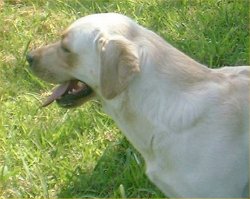
Photo courtesy of Little River Labradors |
One of this
girl's parents is fox red. You'd never know it to
look at her since she's a beautiful light creme. |
Remember too, there are various
shades and shading in all these various shades and shading.
Its endless.
All of these shades are correct
as per the standard. Any of these dogs would be correct
for color either in the show ring or as beloved pets. However,
color or a shade of that color should be secondary to temperament/health
when selecting a dog.
When contacting Labrador breeders
it would be best to use these terms rather than Golden, Cinnamon,
Honeybacked, Lemon, White, etc. This way you will sound
more knowledgeable and the breeder will understand exactly what
you mean. Also, it will keep the breeder from heaving a sigh and
launching into an explanation of what the proper terms are.
*grin*
Run, don't walk away, from anyone
who advertises yellows as white, champage, polar bear, cinnamon
or any other color but yellow.
Copyright © Woodhaven Labradors All rights reserved.
The content on this website is not public domain
Please do not download or copy our pictures, graphics or text.
You may freely link to this page, but use of
any of the text or pictures on another website without my written
permission is copyright infringement and illegal.
If you find this article on another site, please
and let me know.
Site Menu
| Contact the owner
















